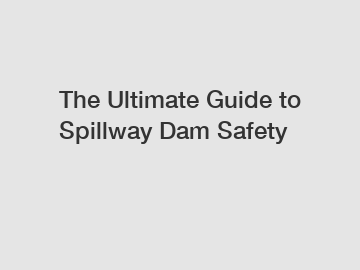The Ultimate Guide to Spillway Dam Safety
Spillway dams are vital structures designed to control and manage water flow in rivers, streams, and other bodies of water. They play a crucial role in preventing floods, conserving water, and providing hydroelectric power to communities. However, despite their many benefits, spillway dams can also pose a significant safety risk if not properly maintained and monitored.
In this ultimate guide to spillway dam safety, we will explore the key aspects of ensuring the safety and integrity of these structures. From regular inspections to emergency protocols, we will cover everything you need to know to protect people and properties from the potential dangers associated with spillway dams.
Regular Inspections.

One of the most important aspects of spillway dam safety is regular inspections. These inspections should be conducted by qualified engineers and technicians who can identify any signs of wear and tear, structural weaknesses, or other issues that could compromise the integrity of the dam.
Inspectors will typically look for signs of erosion, cracking, or settlement in the dam structure, as well as any debris or vegetation that could obstruct the spillway. They will also check the operation of the spillway gates and other control mechanisms to ensure they are functioning correctly.
In addition to visual inspections, engineers may also use advanced technologies such as drones, sensors, and sonar to assess the condition of the dam and detect any potential problems that may not be visible to the naked eye.
Emergency Protocols.
Despite the best efforts to maintain and monitor spillway dams, emergencies can still occur. It is essential to have well-defined emergency protocols in place to respond quickly and effectively to any potential threats to the dam's safety.
Emergency protocols should include procedures for notifying relevant authorities, evacuating at-risk areas, and implementing emergency repairs to prevent a catastrophic failure of the dam. Regular drills and exercises should be conducted to ensure that all personnel involved in dam safety are familiar with their roles and responsibilities in the event of an emergency.
Community Engagement.
Community engagement is another crucial aspect of spillway dam safety. It is essential to educate local residents about the potential risks associated with the dam and how they can keep themselves safe in the event of an emergency.
Public awareness campaigns, public meetings, and educational materials can help raise awareness of the importance of dam safety and empower residents to take proactive steps to protect themselves and their communities.
Environmental Impact.
In addition to ensuring the safety of the dam itself, it is also important to consider the environmental impact of spillway dams. Dams can have significant effects on the ecosystems and habitats of surrounding areas, so it is essential to manage them in a way that minimizes their negative impact on the environment.
This can include strategies such as fish ladders to allow fish to migrate upstream, sediment management to prevent the build-up of debris in the reservoir, and vegetation management to protect habitats around the dam.
Conclusion.
Spillway dams play a critical role in managing water resources and protecting communities from floods. However, they also pose a potential safety risk if not properly maintained and monitored. By conducting regular inspections, developing emergency protocols, engaging with the community, and considering the environmental impact of the dam, stakeholders can work together to ensure the safety and integrity of spillway dams for the benefit of all.
In conclusion, the ultimate guide to spillway dam safety is about recognizing the importance of these structures, understanding the risks they pose, and taking proactive steps to mitigate those risks. By following the recommendations outlined in this guide, we can all contribute to the safe and effective management of spillway dams for years to come.
If you are looking for more details, kindly visit Melting Deicing Device, rubber dam design for Thailand, inflatable rubber dam for Laos.

Comments
0